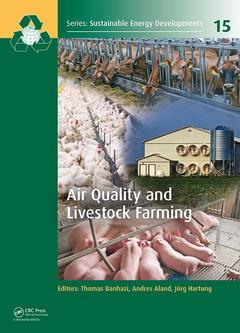Description
Air Quality and Livestock Farming
Sustainable Energy Developments Series
Coordinators: Banhazi Thomas, Aland Andres, Hartung Jörg
Language: English
Subjects for Air Quality and Livestock Farming:
Keywords
Flux Chamber Measurements; Hydrogen Sulfide; buildings; Livestock Buildings; dust; Pm Concentration; concentration; PM10 Emission; pig; Respirable Dust Concentrations; particulate; Fine Pm Concentration; matter; Dust Concentrations; concentrations; High NH; animal; Pig Buildings; health; Odor Emission; emission; Swine Facility; Steven J; Hoff; Ammonia Emissions; Albert J; Heber; Respirable Dust; Ji-Qin Ni; Dust Reduction; Teng-Teeh Lim; Moisture Content; Annamaria Costa; Pm Emission; Cinzia Domeneghini; Respirable Particle Concentrations; Hendrik Jan van Dooren; Emission Rates; Francis Sanderink; Hydrogen Sulfide Concentrations; Annemieke Hol; Manure Pit; Paul Galama; Average TSP Concentration; Marek Maasikmets; BAL Sample; Erik Teinemaa; TSP Concentration; Allan Kaasik; Untreated H2; Veljo Kimmel; Christelle Fablet; Fabrice Bidan; Virginie Dorenlor; Florent Eono; Eric Eveno; Nicolas Rose; François Madec; Kelley J; Donham; Dino Pisaniello; Yu Zhang; Clive J.C; Phillips; Jens Seedorf; Chaoyuan Wang; Lingying Zhao; Hisamitsu Takai
· 17.4x24.6 cm · Hardback
Description
/li>Contents
/li>Readership
/li>Biography
/li>
Air quality has a direct influence on health, welfare and production performance of livestock as the high concentrations of noxious gases, dust and airborne microorganisms are likely to reduce production efficiency and the general welfare of farm animals. Long term exposure to particulates in livestock buildings might also affect the respiratory health of farm workers. Dust in animal buildings contains many biologically active substances such as bacteria, fungi, endotoxins and residues of antibiotics (as a result of veterinary treatments) that are suspected to be hazardous to human health. Furthermore, air pollutants emitted from livestock buildings can reduce air, water and soil quality and can potentially undermine the health of nearby residents. Airborne emissions include ammonia, methane, nitrous oxide, particulates like dust and microorganisms. In addition, other potentially harmful substances such as heavy metals, antibiotic residues and components of disinfectants might be also emitted from livestock building that are potentially damaging to ecosystems.
In this book, key aspects of agricultural air quality, such as monitoring, managing and reducing airborne pollutants in and around livestock facilities are reviewed.
Features:
This book will be useful for farming professionals, academics, students, policy makers, business leaders, regulatory bodies and agricultural consultants.
Section I: Characteristics and sources of different airborne pollutants
Section II: Measurement issues
Section III: Pollutant levels encountered in livestock buildings
Section IV: Effects of sub-optimal air quality on workers, animals and the environment
Section V: Reduction methods Controlling internal concentrations and emissions from the animal buildings
Section VI: Reduction methods and technologies for controlling airborne pollutants
Associate Professor Thomas Banhazi is currently a Lecturer and Principal Scientist at University of Southern Queensland (USQ) responsible for the delivery of a number of agriculture related courses in addition to supervising a large number of post-graduate students. Associate Professor Banhazi has published in excess of 200 book chapters, journal and international conference papers and has been involved in approximately 40 research projects both in Europe and Australia funded by various government agencies and farmer organisations. He has successfully patented a number of innovative technologies in the US, Australia and Europe and actively engaged in the commercialisation of the patented inventions via his commercialisation companies. His expertise is mainly related to Precision Livestock Farming applications and environmental assessment methods. However, his research interests also include thermal and aerial environment of livestock buildings, the effect of airborne pollutants on the health of animals and workers, emission abatement and livestock waste management technologies.
Associate professor Andres Aland is a Lecturer in Animal Health that involves both teaching and scientific activities at the Chair of Veterinary Bio- and Population Medicine at the Estonian University of Life Sciences. He has supervised a number of post-graduate students and published a large number of journal articles, conference papers and book chapters, including two textbooks published by the Wageningen Academic Publishers. Associate professor Aland has been involved in approximately 10 large research projects both in Estonia and Europe, funded by various governmental or European agencies. His expertise is mainly related to the areas of animal welfare and herd health monitoring in different production systems; environmental risks in production animal housing and preventive veterinary medicine. He is the Vice President of the International Societ




